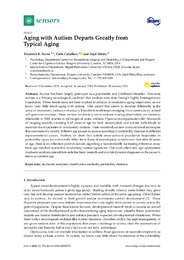Please use this identifier to cite or link to this item:
https://hdl.handle.net/11000/34263Full metadata record
| DC Field | Value | Language |
|---|---|---|
| dc.contributor.author | Caballero, Carla | - |
| dc.contributor.author | Mistry, Sejal | - |
| dc.contributor.author | Torres, Elizabeth B. | - |
| dc.contributor.other | Departamentos de la UMH::Ciencias del Deporte | es_ES |
| dc.date.accessioned | 2025-01-10T09:07:54Z | - |
| dc.date.available | 2025-01-10T09:07:54Z | - |
| dc.date.created | 2020 | - |
| dc.identifier.citation | Sensors | es_ES |
| dc.identifier.issn | 1424-8220 | - |
| dc.identifier.uri | https://hdl.handle.net/11000/34263 | - |
| dc.description.abstract | Autism has been largely portrayed as a psychiatric and childhood disorder. However, autism is a lifelong neurological condition that evolves over time through highly heterogeneous trajectories. These trends have not been studied in relation to normative aging trajectories, so we know very little about aging with autism. One aspect that seems to develop di erently is the sense of movement, inclusive of sensory kinesthetic-rea erence emerging from continuously sensed self-generated motions. These include involuntary micro-motions eluding observation, yet routinely obtainable in fMRI studies to rid images of motor artifacts. Open-access repositories o er thousands of imaging records, covering 5–65 years of age for both neurotypical and autistic individuals to ascertain the trajectories of involuntary motions. Here we introduce new computational techniques that automatically stratify di erent age groups in autism according to probability distance in di erent representational spaces. Further, we show that autistic cross-sectional population trajectories in probability space fundamentally di er from those of neurotypical controls and that after 40 years of age, there is an inflection point in autism, signaling a monotonically increasing difference away from age-matched normative involuntary motion signatures. Our work offers new age-appropriate stochastic analyses amenable to redefine basic research and provide dynamic diagnoses as the person’s nervous systems age. | es_ES |
| dc.format | application/pdf | es_ES |
| dc.format.extent | 21 | es_ES |
| dc.language.iso | eng | es_ES |
| dc.publisher | MDPI | es_ES |
| dc.relation.ispartofseries | 20 | es_ES |
| dc.relation.ispartofseries | 2 | es_ES |
| dc.rights | info:eu-repo/semantics/openAccess | es_ES |
| dc.rights | Attribution-NonCommercial-NoDerivatives 4.0 Internacional | * |
| dc.rights.uri | http://creativecommons.org/licenses/by-nc-nd/4.0/ | * |
| dc.subject | stochastic analyses | es_ES |
| dc.subject | classification methods | es_ES |
| dc.subject | probability distance | es_ES |
| dc.subject.other | CDU::7 - Bellas artes::79 - Diversiones. Espectáculos. Cine. Teatro. Danza. Juegos.Deportes | es_ES |
| dc.title | Aging with Autism Departs Greatly from Typical Aging | es_ES |
| dc.type | info:eu-repo/semantics/article | es_ES |
| dc.relation.publisherversion | https://doi.org/10.3390/s20020572 | es_ES |

View/Open:
2020_JCR_12_Sensors_Aging with Autism Departs Greatly from Typical Aging.pdf
4,22 MB
Adobe PDF
Share:
.png)
